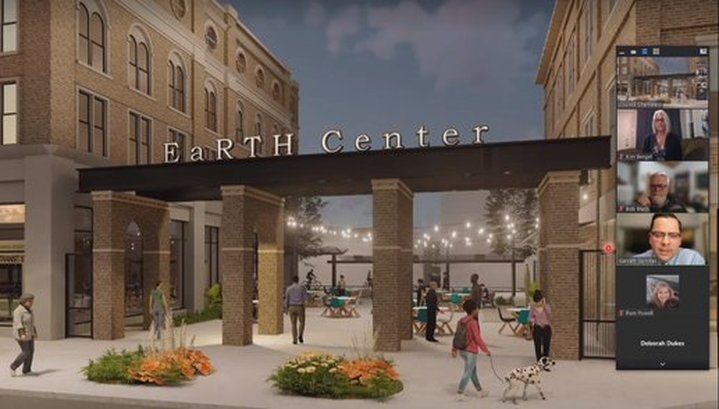The EaRTH Center gateway, pictured in a slide presented at the Feb. 9 Eureka City Council meeting.
The Eureka City Council unanimously approved a resolution Tuesday to remove the two city-owned parking lots on Third Street between G and H streets, behind Lost Coast Brewery, from the city’s Parking Assessment District (PAD) to make way for the recently approved EaRTH Center.
As detailed in the agenda summary, the PAD was created in 1954 and encompassed most of the city’s central business district. “During that time, the city council approved issuance of bonds for the acquisition and construction of off-street parking facilities, and in 1955, a bond was formally issued and the City began to acquire and develop parking lots.”
The PAD is no longer collecting assessments. However, any lot funded by the PAD must go through a public hearing process to allow for the lot to be reduced or removed by a developer.
Although Tuesday’s discussion was a procedural follow-up to the council’s recent approval of the ambitious housing and transit project, several local business owners rallied against the development of the lot over concerns about downtown parking capacity.
“In peak season, it’s really hard for a lot of people to park and we really got to take advantage of that,” said Sebastian Elrite, owner of Humboldt Bay Provisions in Old Town Eureka. “The thing to think about, in my perspective, would be if occupancy rates for the businesses and staff are high and everybody’s there at the same time, you definitely need a lot more parking than what’s currently available because we all want to have our seats full and our businesses and people able to come and go as they’re able.”
Megan Kramer, a local real estate agent with Coldwell Banker Cutten Realty, expressed her support for the project and acknowledged that the “housing situation in Humboldt County has become dire,” but requested the council consider an alternative project site.
“As proposed, this project would significantly increase traffic congestion and create unacceptable challenges for parking,” she said. “In the case of parking, we should accept expect conflict to arise with private property owners as tenants of the proposed project and existing users of the public parking lot that will be removed and will trespass onto private property to find a place to park. We should assume private owners will act and to protect their rights.”
Kramer ultimately requested that the council “select an alternative location and to move forward with this project.”
Eureka resident Kelly Martin echoed previous concerns about parking but also said he was worried about a potential increase in crime and “the homeless impact on local businesses.”
Project proponents, including Eureka resident and executive director of the Environmental Protection and Information Center, Tom Wheeler, said the EaRth Center “would be a very good thing for Eureka.”
“It’s going to provide low-income housing for people in our community; it will provide housing for traveling medical professionals, and will provide student housing,” he said. “I think [it] is really going to be wonderful for Old Town [and] it’s going to give us a shot in the arm of youthful energy. …This transit center is going to benefit the whole of the city, but in particular, it’s going to benefit our Old Town-downtown core.”
Wheeler added that public land “should be put to the best public use” and urged the council to continue its support for the project.
Colin Fiske, executive director of the Coalition for Responsible Transportation Priorities, said, “It’s past time that we devote some resources, some funding to develop a transit center downtown.”
“We have plenty of parking and we need to give transit a try,” he said. “… Last time we were here it was a very full discussion. There were a lot of members of the public here. You had a good discussion and you made the decision to support the EaRTH Center. This is really bureaucratic sort of hoops that you have to jump through tonight and I hope that you will just continue on as planned.”
Following public comment, Councilmember Leslie Castellano acknowledged the need for more long-term parking throughout Old Town and downtown. “We are looking at some new solutions so that folks who are working those six- or eight-hour shifts can park … so they don’t have to worry about getting a big ticket or something like that.”
Councilmember Scott Bauer asked City Manager Miles Slattery to address concerns surrounding the price of the project, which is estimated to cost roughly $680,000 per unit.
“That is incorporating all of it but it is expensive,” Slattery said. “The cost of construction, as anybody will tell you, is very expensive right now. … When you take into consideration the transit center and the commercial space down below, it’s close to $500,000 a unit. That’s the going rate but it’s expensive right now.”
Councilmember Natalie Arroyo criticized the notion that additional low-income housing would contribute to more crime in Old Town and downtown, noting that she had only recently risen above the low-income bracket.
“I continue to take issue with this way that people are characterizing low-income folks in the community because I recently very recently became not low income,” she said. “… I’ve said this before, but low-income people statistically spend more of their money locally, so there’s also that benefit. I really get frustrated to hear any disparaging of the poor working folks in our community and students in our community who are still here being a part of the community, and any disparaging of transit riders. Frankly, that’s something I can’t quite stomach.”
Councilmembers Katie Moulton and Kim Bergel agreed. Bergel subsequently made a motion to adopt the resolution to remove the two city lots from the PAD. The vote passed in a unanimous 5-0 vote.
The full discussion can be found here.

CLICK TO MANAGE